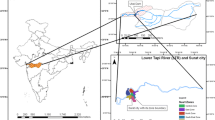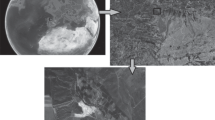Abstract
In this study, the simulation and analysis of the inundation in a coastal urban area according to the storm surge height are carried out using a two-dimensional finite-volume model with a well-balanced scheme. The target coastal urban area considered in this study is a part of the new town of Changwon city, Gyeongnam province, South Korea; this area was extremely damaged by the storm surge generated during the period of Typhoon Maemi in September 2003. For the purpose of the verification of the numerical model applied in this study, the simulated results are compared and analyzed with the temporal storm surge heights observed at the tide station in Masan Bay and inundation traces in an urban area. Moreover, in order to investigate the influence of super-typhoons possible in the future, the results simulated with the storm surge heights, which were 1.25 and 1.5 times higher than those observed during the period of Typhoon Maemi, are compared and analyzed.













Similar content being viewed by others
References
Bao JW, Wilczak JM, Choi JK, Kantha LH (2000) Numerical simulation of air-sea interaction under high wind conditions using a coupled model: a study of hurricane development. Mon Weather Rev 128(7):2190–2210
Billet SJ, Toro EF (1997) On WAF-type schemes for multi-dimensional hyperbolic conservation laws. J Comput Phys 130(1):1–24
Cheung KF, Phadke AC, Wei Y, Rojas R, Douyere YJM, Martino CD, Houston SH, Liu PL-F, Lynett PJ, Dodd N, Liao S, Nakazaki E (2003) Modeling of storm-induced coastal flooding for emergency management. Ocean Eng 30(11):1353–1386
Choi BH, Eum HM, Woo SB (2003) A synchronously coupled tide-wave-surge model of the Yellow Sea. Coast Eng 47:381–398
Clawford NH, Linsley RK (1966) Digital simulation in hydrology: standard watershed model IV. Technical Report No. 39, Department of Civil Engineering, Stanford University, Stanford, pp 1–210
Harten A, Lax P, van Leer A (1983) On upstream differencing and Godunov-type scheme for hyperbolic conservation laws. Soc Ind Appl Math Rev 25(1):35–61
Honnorat (2007) Assimilation de donnees lagrangiennes pour la simulation numerique en hydraulique fluvial, Ph.D. Thesis, Institute National Polytechnique de Grenoble, France, pp 1–144
Hur DS, Yeom CS, Kim JM, Kim DS (2006a) Estimation of storm surges on the coast of busan. J Korean Soc Coast Ocean Eng 20(3):37–44
Hur DS, Yeom CS, Kim JM, Kim DS, Bae KS (2006b) Storm surge characteristics according to the local peculiarity in gyeongnam coast. J Korean Soc Coast Ocean Eng 20(3):45–53
Hur DS, Lee HW, Lee WD, Bae KS (2008) Storm surge height on Busan and Gyeongnam coastal region by an attack of super Typhoon. J Korean Soc Coast Ocean Eng 20(1):128–136
IPCC (2007) Climate change 2007: synthetic report, pp 1–34
Kim DS, Kim JM, Lee GH, Lee SD (2007) Inundation analysis considering water waves and storm surge in the coastal zone. J Ocean Eng Technol 21(2):35–41
Kim DH, Cho YS, Kim HJ (2008) Well-balanced scheme between flux and source terms for computation of shallow-water equations over irregular bathymetry. J Eng Mech 134(4):277–290
Lee JS (2011) Fluid mechanics for civil engineers, Goomibook, Seoul, pp 1–518
LeVeque RL, George DL (2004) High-resolution finite volume methods for the shallow water equations with bathymetry and dry states. Proceedings of the Third International Workshop on Long-Wave Runup Models, Advances in Coastal and Ocean Engineering, Catalina, Vol. 10, pp 43–73
Loukili Y, Soulaïmani A (2007) Numerical tracking of shallow water waves by the unstructured finite volume WAF approximation. Int J Comput Methods Eng Sci Mech 8:1–14
Moon IJ, Oh IS (2003) A study on the effect of waves and tides on storm surge using a coupled ocean wave-circulation model. Asia Pac J Atmos Sci 39(5):563–574
Moon SR, Park SJ, Kang JW, Yoon JT (2006) Numerical simulation of storm surge/coastal flooding at Mokpo coastal zone by MIKE21 model. J Korean Soc Coast Ocean Eng 18(4):348–359
Ozer J, Palilla-Hernandez R, Monbaliu J, Fanjul EA, Albiach JCC, Osuna P, Yu JCS, Wolf J (2000) A coupling module for tides, surges and waves. Coast Eng 41(1–3):95–124
Perthame B, Simeoni C (2001) A kinetic scheme for the Saint-Venant extended Kalman Filter for data assimiliation in oceanography. Calcolo 38(4):201–231
Toro EF (2001) Shock-capturing methods for free-surface shallow flows. Wiley, New York, pp 1–309
Acknowledgment
This work was supported by Kyungnam University Foundation Grant, 2013.
Author information
Authors and Affiliations
Corresponding author
Rights and permissions
About this article
Cite this article
Jeong, W. A study on simulation of flood inundation in a coastal urban area using a two-dimensional well-balanced finite volume model. Nat Hazards 77, 337–354 (2015). https://doi.org/10.1007/s11069-015-1603-3
Received:
Accepted:
Published:
Issue Date:
DOI: https://doi.org/10.1007/s11069-015-1603-3




